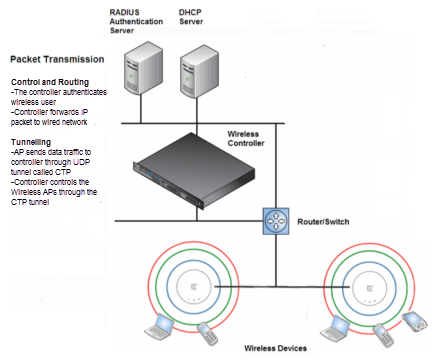The following figure illustrates a typical configuration with a single ExtremeWireless Appliance and two ExtremeWireless APs, each supporting a wireless device. A RADIUS (Remote Authentication Dial In User Service) server on the network provides user authentication, and a DHCP (Dynamic Host Configuration Protocol) server assigns IP addresses to the Wireless APs. Network inter-connectivity is provided by the infrastructure routing and switching devices.

An authentication server that assigns and manages ID and password protection throughout the network. The RADIUS server system can be set up for certain standard attributes such as Filter ID, which can be used to provide policy assignment indications for a specific user, and for the vendor specific attributes (VSAs). The appliance does not implement its own RADIUS server but rather depends on the interaction with infrastructure (customer) available servers. This facilitates the centralization of user policy for wireless and other access methods.
A server that assigns the IP addresses, gateways, and subnet masks dynamically. The external DHCP server, depicted in Figure 1-1, is used to provide addresses to infrastructure equipment such as APs. If you do not have a DHCP server, you can configure the appliance's built-in DHCP server to provide the IP addresses to infrastructure equipment, including the APs (if the APs are connected on the same segment as the corresponding controller port on which the service is enabled). In addition, the IP addresses to the mobile devices are provided by the built-in DHCP server of the appliance. You can also configure the appliance to relay DHCP requests to the external DHCP server.
A service discovery protocol that allows computers and other devices to find services in a local area network without prior configuration. The client applications are user agents and services that are advertised by a service agent. In larger installations, a directory agent collects information from service agents and creates a central repository. SLP is one of several modes that the Wireless APs use to discover the appliance.
A server that translates the domain names into IP addresses. The DNS is used as an alternative mechanism for the automatic discovery process. In addition to an end-user‘s usage of DNS to obtain IP references to common internet resources (web-sites), it may also be used as an alternative method for AP-Controller discovery. The ExtremeWireless Appliance, its software, and the APs rely on the DNS for Layer 3 deployments. In addition, appliances use DNS to discover their controller. The appliance can be registered in DNS as controller.<domain> to provide DNS-assisted discovery by APs